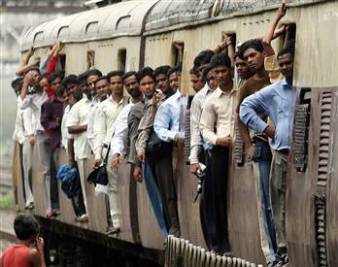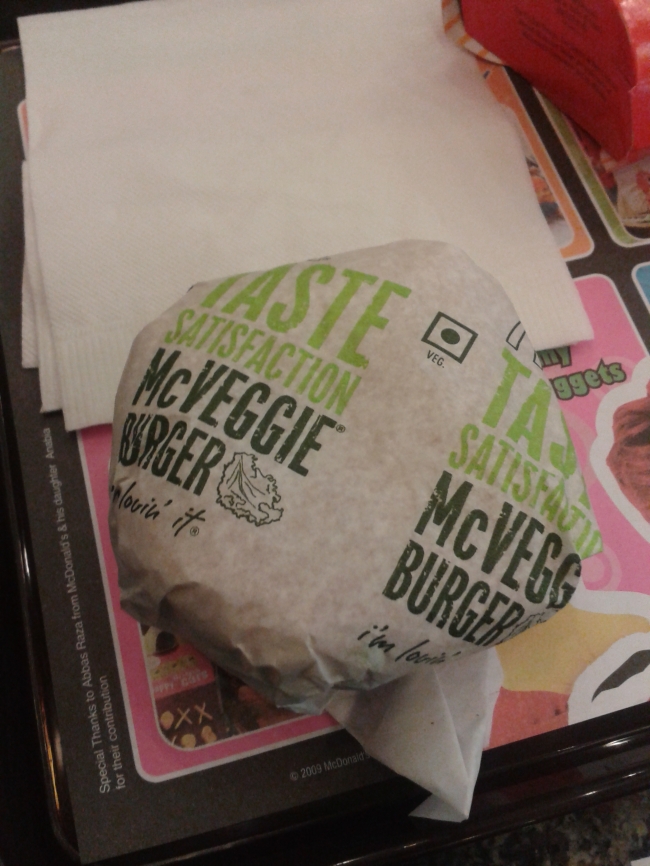Its been a little over a week since I landed in Mumbai (which all the locals still call Bombay). As I will be spending the majority of the next 9 months of my life here, the following are a few initial thoughts:
People are generally really nice…when they’re not trying to rip you off
The first cab driver I had the pleasure of encountering here in Mumbai covered the meter with a red piece of cloth as soon as I got in and refused to show, or turn on the meter even after I had repeatedly asked very nicely (cabs are legally required to charge you by the meter here in Mumbai btw). Each one of my requests was met with an ‘it’s ok’, ‘no problem’, or finally ‘no english’. So naturally, my first cab ride ended with a shouting match and me abruptly walking out into the middle of the street.
However, other than a few greedy cab drivers trying to make a quick buck off someone who obviously sticks out like a sore thumb, most of the people I’ve encountered so far have been both incredibly nice and helpful. Case in point:
This past weekend, I went with a couple of people to do some hiking at Matheran, a hill station located a few hours outside of the main city. Hill stations are towns built by the British on places of higher elevation than the nearby plain/valley (a.k.a hills – creative name, I know), usually for the purposes of escaping the summer heat. When we arrived, it was really coming down and while looking for a place to park, our car gets stuck in the mud.
When this happened, approximately ten people near us all dropped whatever they were doing and spent the next hour trying to help us get the car out. Never mind the rain, the mud all over their clothes, or their original plans. All that mattered at that moment was helping another human being stuck in a shitty situation out. Incredible.
By American standards, things are really cheap
Major props to Mr. Bernanke and crew for hinting (who knows if it’ll actually happen) at ending QE in the near future and subsequently, causing the value of the dollar to rise substantially in the past few months. At the current exchange rate of 60 rupees to the dollar, you can get a really good local meal for under $3 USD, 1 GB of data for your smartphone for about $4 USD, and every cab ride I’ve been in has been under $2 USD. After paying rent, I’m expecting to pocket about $20 USD per day as my stipend here, and believe it or not, I think I can get by quite comfortably. However, the one thing that isn’t all that cheap is alcohol. Apparently Maharashtra has a 100% import tax on all foreign alcohol (the tax varies depending on the state) so getting a Blue Moon here is about the same, or even more, than getting one in San Francisco. Guess it’ll be Kingfisher for me from here on out.
The locals are not morning people
The first day going to work, I left around 9:15 and ended up spending almost half an hour trying to hail a cab as nearly every one that passed by was occupied. When I finally managed to track one down, the traffic was so bad that the ride ended up taking 40 minutes for a journey I would later find out should take less than 15. The next day I left around 8:30 and lo and behold, the streets were damn near empty and multiple cabs were just parked, waiting around for customers. Apparently, morning rush out here doesn’t really happen until 9:30-10:30. Oftentimes I’ll get into the office by 9 and be the first or second person there.
Riding the trains is quite an adventure
I’ve been on my fair share of crowded metros in different cities around the world and riding the trains here in Mumbai is near, if not at, the very top for craziest/most stressful experience. First of all, none of the train cars have any doors, so they’re just all open entrances. People also constantly have their bodies hanging out the entrances, like this:
The stations never announce when a train will leave a station once it arrives, and as there are no doors to close, there is absolutely no indication as to how long a train will stay at a station. So what ends up happening is that, as a train is pulling into a station, before it has even come to a complete stop, there will be a stampede of people trying to get into a car and oftentimes, an equal stampede of people trying to get out. What this ultimately means is that, just in order to board a train, you often have to sprint from car to car looking for an opening to pull yourself into, as many cars will be so packed that they are literally impossible to enter. Never has the simple act of boarding a train felt like such an accomplishment. Good thing I have sharp elbows.
Drivers are crazy…and the honking never stops
Mumbai was built by the British as a port city located on a peninsula. What this means is that there is a lack of room for expansion as the population of both people and automobiles swell. Streets here are generally pretty narrow and most cars are small and narrow as well. Consequently, the locals here drive like crazy people and use every.single.inch of space available on the road. Cars are often mere inches away from each other, and things like lane lines, turn signals and sometimes, even traffic lights don’t really matter. Basically the right of way goes to whoever gets to the spot first. What is one result of cars in close proximity fighting for limited space? Honking. That’s right, constant, never-ending, all hours of the day, honking. Might need to cop some earplugs soon.
Indian food is much better here….the other stuff, not so much
Although I’ve only been here for a week, I can confidently say that most of the Indian food back home is definitely toned down. The local Indian food here is SO much better. Dishes are much more flavorful and most of them are spicy, which is right up my alley. But they’re spicy in a compliment-the-flavor type of way and not in a spicy-just-to-be-spicy type of way. Also, there is wide variety of ‘Indian’ food, usually based on the state and region where it’s from (for example, north Indian food, which is prevalent in the states, is very different than south Indian food). I’ve only tried a small sample of the many different types of Indian cuisine so far, but let’s just say there’s a whole lot more to Indian food than chicken tikka masala.
On the other hand, the ‘other’ cuisines I’ve tried so far (save a pretty decent Thai place, but seriously, even ‘bad’ Thai food is generally pretty good), have been, to put it mildly, disappointing. The other night I went to a ‘Chinese’ restaurant and ordered some chicken chow mein. Pretty safe right? Here’s what it looked like:
WTF is that??
I’ve been to enough countries that I’m fairly certain there is bad Chinese food everywhere, but this definitely takes the cake. Tasteless, not-fully-cooked noodles in a slimy, gooey ‘sauce’, if you could even call it that. I’m generally not that picky but this was borderline inedible.
My first meal in Mumbai was actually this:
Not really the business.
The Indian head bobble
In my brief time here, I’ve already noticed a number of cultural differences, from the terms used in business to the way waiters serve you in restaurants. However, the one thing that stands out the most, and is also the most amusing, to me is the reaction I get when someone agrees, disagrees, or even just a ‘ok’ or ‘I heard you’. Basically, the reaction to anything I say.
I hope I don’t pick this up.
Weather hasn’t been too bad
My biggest concern before coming to Mumbai was the weather. Surprisingly, it hasn’t been too bad thus far. Yes its humid, but as the monsoon season just began, and the rain comes down intermittently throughout each day, the temperature hasn’t been too high. I’d guess 80’s – low 90’s. Bearable. The locals tell me there are 3 months of the year where it’s so hot that its hard to breathe, never mind walk, and that animals will lie down on tile floors to try and escape the heat. Just so happens that those 3 months will be the 3 months of this upcoming year where I’m not here. Stay schemin’.
Poverty is everywhere
Poverty is inescapable in Mumbai. Everywhere you turn, there are people sleeping directly on the streets, or in makeshift homes on the streets (often just a tarp being held up by a couple of wooden sticks). There are seemingly slums on ever other street and I haven’t even been to Dharavi or any of the other large, exclusively slum areas yet. The infrastructure here, particularly the buildings and roads, appear to be crumbling. I’ve yet to run into a building without mold, a sidewalk without cement pieces falling apart, or a street without trash littered everywhere. And this is the financial capital of the country. I can’t imagine what it’ll be like when I go to ‘real’ India.
The people at Technoserve are great
The biggest draw of Technoserve for me, besides the type of work they do, is that they seemingly attract a lot of high caliber people. In this regards, I have definitely not been disappointed. Everyone here seems to be both really smart and down to earth. Our head honcho, the country director, used to be a CEO of a tech company and ex-McKinsey. A number of the other volunteers are either students or graduates of top MBA programs (HBS/Wharton/Columbia/INSEAD/Chicago). One girl goes to Wharton and the Kennedy School at the same time and just so happens to be one of the nicest people I’ve ever met. There are a couple of start-up founders in the mix, as well as people that have done some great things in the development space.
One of my biggest surprises in coming here was how many VolCons (what they call us Volunteer Consultants) there actually are. Apparently there are 30 VolCons at Technoserve around the world currently, and 10 of them are here in India. We definitely make up a core part of the overall team and some VolCons are even leading their respective projects. A few of the managers here also started as VolCons before transitioning into a full-time role. Most of us are in our mid-late twenties and seemingly all down to have a good time, so it almost feels like working at a consulting firm (the work is structured similarly as well) again.
I will be flying to Bhopal this weekend to meet the rest of my project team. Next week I’ll, hopefully, be able to go into the field and actually meet and work with the stakeholders (small farmers). Can’t wait.





Entertaining read! Keep em coming Albert!!
Love the blog. So glad I found it. Sounds like it has been a great ride thus far!